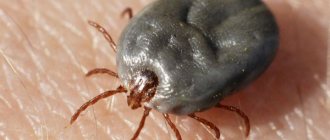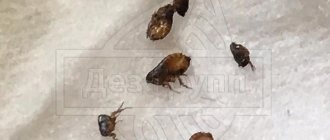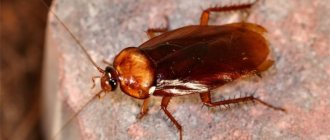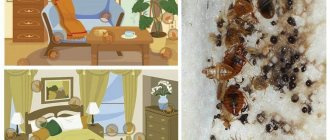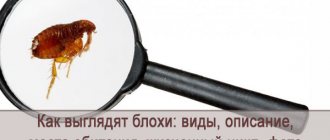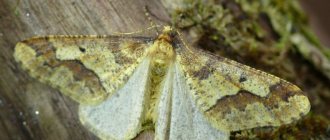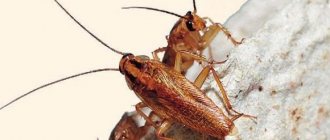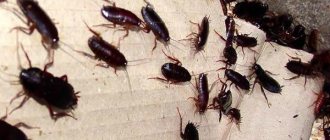Incredible facts
Cockroaches are universally hated. What could be more disgusting than a cockroach? Even the most persistent can't help but grimace in disgust when they see these whiskered insects.
There are about 4,000 species of cockroaches in the world and about 30 of them live in our homes. Despite their relatively small size and our diligent efforts, these creatures have remarkable endurance.
How do cockroaches manage to survive and remain undetected? Here are these and other interesting facts about cockroaches.
Cockroaches will survive a nuclear explosion
Researchers have found that cockroaches and scorpions are the only organisms that can survive the explosion of an atomic bomb. Cockroaches are thought to be able to withstand high levels of radiation because they have a slower cell division cycle and cells are most sensitive to radiation when they are dividing (like those in humans).
TOP 10: Disgusting but interesting facts about cockroaches
The cockroach is an annoying and unpleasant insect that we humans are still not used to and will probably never get used to. And this is despite the fact that cockroaches have long been accustomed to living side by side with us, and seem to enjoy such a relationship. There are many interesting and disgusting facts about cockroaches that many of us don't know. For example, they are superbugs that can live for weeks without vital body parts, they love our ears, and they can bite us when we stop leaving them food. 10. They can live without a head for several weeks
Photo: diegobraghi.blogspot.com
Cockroaches are tough survivors, and it is very difficult to get rid of them. Even depriving a cockroach of its head is not a death sentence for it, because it can live for several weeks without it. He later dies only because he has no mouth to eat or drink. Cockroaches can live without their heads because they don't use their heads the way we do. A person dies soon after beheading because his body loses a lot of blood and his blood pressure drops sharply. Cockroaches don't have much blood and don't have blood pressure. So a clot forms in the neck and they continue to wander around as if nothing had happened.
Even if we humans could find a way to cope with the massive blood loss and drop in blood pressure, we would still die because the nerves in our body are connected to the brain. We also need a nose to breathe and a mouth to eat. Cockroaches' bodies work independently of their tiny brains. They breathe through small holes on their bodies. All these features allow cockroaches to live without a head for several weeks. They suffer only from hunger and thirst, since they have not learned to quench them through the skin.
Interestingly, the cockroach's head remains alive for several hours after decapitation, as evidenced by the moving whiskers. In fact, the head can stay alive longer if it is kept in a cool place and receives enough nutrients.
9. They hate it when people touch them
According to one fact about cockroaches that often appears on the Internet, these creatures hate it when people touch them, so much so that they will often run away to quickly cleanse themselves of this disgusting contact. But everything is not what you think. Cockroaches hate people or anything else that touches them because this simple contact can be life-threatening. More precisely, cockroaches also hate the presence of people, just as people hate the presence of cockroaches. Insects naturally run away from larger creatures (whether humans or otherwise) because they know that any contact with a larger creature often results in death.
In fact, contact with almost any organism can leave some mark on the cockroach that can be harmful to it. In the case of humans, these are natural oils that we unwittingly leave on everything we touch. These secretions can disrupt the functioning of the cockroach's body. The antennae suffer the most. They may seem unremarkable to us, but they are critical to the cockroach's survival. They act like his nose and are essential for smelling food and finding potential mates. These oils will reduce the pest’s sense of smell, which is dangerous for it.
8. They like our ears
You may have read stories of cockroaches crawling into people's ears, or even crawling up the ear canals and into their skulls. In severe cases, cockroaches can lay eggs in the host's head or die there. It turns out that these stories don't appear as often as they should. Cockroaches should get into our ears more often than they do. As stated earlier, cockroaches often avoid people. However, they like to move around in the dark when people are sleeping. And they don't seem to be too fussed about walking over a sleeping person.
The wax in our ears releases volatile fatty acids, chemicals that are also released by foods such as bread and cheese. Volatile fatty acids attract cockroaches. Having stumbled upon a human ear, a cockroach understands that it is narrow, stuffy and warm - this is exactly the kind of house they like. What creature would refuse a free home with free food?
Unfortunately, this quickly becomes a problem for the cockroach and the sleeping person. The movements of a cockroach in the ear can cause a sleeping person to scratch their ear. This pushes the cockroach deeper into the ear or even kills it if you press too hard. A live cockroach may end up deep inside the ear or even inside the skull. The spines on a cockroach's legs can damage the inner ear, causing infection or even hearing loss if the eardrum is damaged. A dead cockroach is also a problem, but a squashed one is an even bigger problem. Cockroaches have deadly bacteria in their guts that can cause unpleasant health problems.
7. They can bite people
Photo: pestkilled.com
Cockroaches are omnivores: they eat both plants and animals. In fact, they eat everything, even if it is a living person. Yes! Cockroaches can bite people. To be clear, cockroaches do not always want to bite a person. They usually prefer other food sources. They also do not bite when attacked by humans. Instead, they usually try to escape.
However, they may start biting people and even pets when there are so many other cockroaches around that there is not enough food for everyone. But even in this situation, they will still try to avoid biting people. Most often, a cockroach bites when it finds small particles of food on the body of a sleeping person. They can usually be found around the fingers, hands and feet, which is where cockroach bites typically occur. The bites can be painful and have been compared to those of a huge cockroach-sized mosquito. After a bite, it is recommended to treat the affected area, because the cockroach can introduce dangerous bacteria into your body.
6. They used to love sugar, but now they hate it.
Cockroaches love sugar. They will like you if you leave candy, cakes, fruits and juice with high sugar content on the table. Leave the regular sugar and they will love you forever. The pest control industry discovered this in the 1980s. They noticed that spilled sugar caused cockroaches to flock to the area. Therefore, they began to use glucose to attract cockroaches, mixing it with insecticides. After eating such food, the cockroaches died and returned to their homes. Other cockroaches often ate the remains of the dead, which is not surprising, since these creatures eat almost everything. Scavengers also died because the dead cockroaches still had poison in their bodies. This went on for some time until the cockroaches realized that the sugar was killing them.
Later, cockroaches began to resist sugar. Their senses quickly adapted to perceive sweet sugar as bitter. Many pest control companies discovered this and immediately replaced glucose with fructose, another sugar. Cockroaches quickly realized this and began to avoid fructose. Scientists have traced this amazing ability to "switch taste" back millions of years, when cockroaches first developed the ability to detect the sweet but poisonous parts of certain plants that they perceived as bitter. This skill was genetically suppressed when they began to live among people and was restored when people began to feed them poisoned food.
5. Termites are cockroaches
Photo: smithsonianmag.com
Termites and cockroaches belong to the same order, Blattodea. So termites are theoretically cockroaches. Interestingly, until 2018 they did not think so. Until this point, termites were classified in the order Isoptera. Research into the similarities between these creatures began in 1934, when researchers discovered that their intestines contained similar microbes. A research paper published in 2007 conclusively confirmed that they are related and recommended that the taxonomic rank be adjusted to place them in the same family. In fact, the article proposed treating the orders Blattodea (for cockroaches) and Isoptera (for termites) as subfamilies within a new family called Termitidae.
Several scientists from the Entomological Society of America then refused this proposal because they did not want termites to be considered cockroaches. In addition, there was already another family Termitidae in the taxonomic rank, which could have caused confusion. Later, in 2018, the ESA put the issue to a vote and backed down, agreeing to classify termites as cockroaches. The ESA reclassified the order Isoptera as a suborder and placed it in the cockroach order Blattodea, rather than creating a new family as proposed in 2007.
But this does not mean that termites should be called “cockroaches.” Termites should be called "termites" and cockroaches should be called "cockroaches". Remember the saying that a tomato is a fruit, but you shouldn't put it in a fruit salad? The situation is similar here. “Knowledge is knowing that a termite is a cockroach. Wisdom is not to call him a cockroach.”
4. They Can “Shift Gears” While Running
Anyone who has ever tried to kill a cockroach quickly realizes that they move very quickly for their size. It looks like we shouldn't be surprised because some cockroaches can change their speed. Scientists have compared this to the way horses transition from a trot to a gallop, or the way cars change gears to accelerate. Cockroaches don't change gears like cars because their scientists haven't yet invented cockroach cars. Instead, they "switch gears" by changing the position of their legs as they run.
Scientists noticed this when they studied the cockroaches Nauphoeta cinerea in 2022. Like most other cockroaches, these roaches run away when they spot a larger creature nearby. When a cockroach runs, the middle leg on one side of the body and the front and back legs on the other side of the body simultaneously touch the ground. This is called alternating three-legged walking. However, such running is not fast enough, consumes a lot of energy and makes the fleeing cockroach unstable. Thus, the cockroach begins to use a metachronous step, when all legs on one side leave the ground in this order - front, middle and back. They touch the ground in the same order.
3. Their brains could be used to create life-saving drugs.
Here is a disgusting fact that could change medicine forever. Scientists are working to develop drugs that could treat E. coli and MRSA (methicillin-resistant Staphylococcus aureus), two deadly antibiotic-resistant bacteria, using chemicals extracted from the brains of cockroaches. Researchers discovered that tissue from the cockroaches' brains killed these bacteria when they examined how locusts survived in polluted environments in the Middle East. Cockroaches became involved when researchers decided to find out how these creatures managed to survive in sewage and sewage without dying from the terrible bacteria that infest such places.
Researchers have discovered that locusts' nerves, as well as their brains and the brains of cockroaches, contain chemicals that kill these dangerous bacteria. Researchers have not been able to confirm exactly what these substances are. They are still trying to find the answer and hope to use them in the future to develop antibacterial drugs.
2. They can make joint decisions
Cockroaches are smarter than we think. They can even make decisions in groups, like many other insects and animals. Several years ago, Dr. Jose Halloy of the Free University of Brussels, Belgium, conducted a study observing how cockroaches think. He put several cockroaches in a dish with three houses on it and waited for them to separate.
Dr. Holloy noted that the cockroaches first gathered together, touching each other with their antennae. After some time, they divided equally into their homes. For example, 50 cockroaches split into two groups of 25 each when they were given three houses with a capacity of 40 cockroaches each. One group lived in the first house, and the other in the second. The third house was empty. All 50 cockroaches also decided to live in one house when they were given three houses that could accommodate more than 50 cockroaches each.
1. If they disappear, the ecosystem will be destroyed
Cockroaches may be hated, but they are critical to the balance of an ecosystem. If they ever disappear, our ecosystem will be severely devastated. First, the extinction of cockroaches will have a direct impact on the populations of many species of birds, rats and mice that feed on them. These animals will not go completely extinct because they usually feed on other organisms and sometimes plants. But their number will decrease.
In turn, reducing the population of these animals will reduce the number of feral cats, wolves, coyotes, eagles, reptiles and some other creatures that feed on birds, rats and mice. And this will continue. The hardest hit will be certain species of wasps that rely on cockroaches to maintain their life cycle. These wasps will go extinct because the cockroaches will go extinct. Forests will suffer if cockroaches disappear because these pests feed on decaying matter, which is often high in nitrogen. Cockroaches eat this nitrogen along with decaying matter and then excrete it. Their nitrogen-rich excrement is later absorbed into the soil, which supports plant growth.
And the absence of cockroaches will deprive the soil of nitrogen. This means that the soil will not be able to support enough plants to grow, which will affect the populations of creatures that feed on those plants and the predators that feed on those creatures. This will continue until the top of the food chain gets its turn. So guys, we'll just have to deal with the cockroaches.
Biggest
The Madagascar cockroach is the largest in the world. Males grow up to 60 mm, and females up to 55 mm. This species hisses unusually when moving. This feature is often used by film sound engineers to create a scary effect.
There is another record holder. It is found in Queensland, Australia. Adult specimens grow up to 8 cm and weigh 30 grams. They also hold the record for life expectancy, living up to 9 years.
11
Horsefly
This large, fleshy fly with large wings and simply huge eyes ranks fifth among record-breaking insects in terms of speed. It flies very quickly, covering 50-55 km in an hour. Horseflies are amazingly hardy, easily adapt to even the most unfavorable living conditions, and they are also very voracious - one individual drinks as much blood at a time as 70 mosquitoes can handle.
Appearance of insects
The sizes of representatives of the cockroach order vary from 4-6 mm to 8 - 10 cm. Color can vary from red to black, passing through all shades of brown. But the appearance and body structure of all cockroaches are similar. Character traits:
- the body is elongated, oval, slightly flattened;
- rather large head in the shape of a rounded triangle;
- thin long legs (since cockroaches are insects, all representatives of the order have 3 pairs of legs);
- long mustache.
The body of insects is covered with a chitinous membrane.
Name
There is always a special meaning hidden in any scientific definition. Philologists have not yet come to a consensus on what word the name “cockroach” comes from. Wikipedia provides several versions.
Some believe that it comes from the Chuvash tar-aqan, meaning “running away.” For comparison, in Turkic languages there is a verb “täz”, that is, “to run away”. There is a version that the etymology is rooted in the Turkic name tarxan, which translates as “dignitary”.
2
Features of reproduction
In order to bear offspring, a female cockroach only needs to mate with a male once. After this, seminal fluid remains in the female’s body, which is enough to lay eggs throughout her life.
Cockroaches go through three stages of development:
- egg;
- nymph (larva);
- imago (adult).
The egg stage lasts 3-4 weeks, after which a small white larva is born. Very soon the outer cover of the larva becomes stronger and darkens. Small cockroaches look like adult insects only without wings. During the formation period, the nymph experiences up to 6 molts, after each of which the larva becomes more and more similar in structure to an adult cockroach. The nymph stage lasts, depending on the type of insect, from 3-4 weeks to 2-4 years. An adult is a sexually mature insect, ready to mate.
Honey bee
Like a dragonfly, a bee can fly at a speed of 60 km per hour. But she often flies with nectar, which weighs as much as one insect. With a full honey ventricle, the worker bee already flies at a speed of 30-33 km per hour, which is why it ranks second in the “Fastest Insects” rating.
But in terms of the distance that a bee can cover, it is far ahead of a dragonfly: to produce just 1 kg of honey, an insect flies at least 450 thousand km, which is about 10 Earth equators!
Harm
Red and black are synanthropes. Their way of life is closely connected with man and his home. In addition to spreading diseases, they damage book bindings, leather goods and furniture.
The presence of moisture is important for them to live, but they can also eat food. The American cockroach can get into your home along with fruit.
Don’t miss out, on our website topcafe.su you can find out the 10 main reasons why insects are important.
15
Australian dragonfly
In the course of scientific research, entomologists have found out which is the fastest insect on our planet. This is the Australian dragonfly, or Austrophlebia costalis. Due to its large size it is often called the “southern rocker”. In one hour of flight it covers at least 60 km! This achievement is even listed in the Guinness Book of Records. Some scientists claim that the dragonfly is capable of flying at a speed of 100 km/h, but so far there is no documentary evidence of this theory.
How does the Australian dragonfly fly? This is the fastest insect on Earth, flapping its wings 100-150 times in one second. When she needs maneuverability in pursuit of prey, she flaps her hind and front wings alternately, and to develop super speed, she flaps them simultaneously. It is known that dragonflies are capable of covering enormous distances, moving more than a thousand km from home.
What other fastest insects live in our world? Read about them further.
Abdomen
It consists of 11 segments, on the last one, males have cervical processes that do not represent any benefit to the insect. In females, the ootheca is located in this place. Up to 16 larvae develop in it after each fertilization. At the anal end of the abdomen, near the cerci, the hearing organs are located.
Interesting!
The weight of an adult cockroach is less than 8 mg. The body size increases gradually as the nymph grows, and does not exceed 15 mm in length.
Appearance of a cockroach Nymphs only after 5 molts grow wings, form genitals, and lengthen their whiskers. The internal structure of a cockroach is just as surprising as its external structure.
Other record holders
This is what the top 5 fastest insects in the world look like. But there are other representatives that move on land or fly through the air very quickly. For example:
- hawkmoth butterflies in flight reach a speed of 45-50 km/h, they are also able to hover motionlessly over a flower for a long time, sucking nectar from it with their proboscis;
- hornets cover 25-28 km in an hour;
- water striders run on the surface of the water at a speed of 4 km per hour, while their paws remain completely dry! Another mystery of nature;
- fleas - these nasty insects move in jumps at a speed of 6 km per hour;
- Locusts travel 20 km or more in an hour in search of food.
Now you know what the fastest insects live in the world, what features they differ from.
Jumping beetle
The jumping beetle is one of the fastest among insects, whose movement speed can sometimes exceed 2 meters per second. It can be classified as a beneficial insect that destroys pests in gardens and vegetable gardens. One horse can destroy more than 400 harmful insects over the summer. They go hunting in sunny weather. The beetle flies at high speed, but only for short distances. Sensing danger, he instantly rises into the air and, having flown a short distance, falls down. These arthropods can hunt on the fly, but obtain their main food on the ground, chasing insects or larvae. Being one of the fastest runners among his relatives, the hunter easily catches up with the fastest prey. Having grabbed hold of the prey with its powerful jaws, the beetle generously pours gastric juice with digestive enzymes onto it. Under the influence of the juice, the internal organs of the caught prey are partially digested, and after some time the fish can only suck out the nutritious gruel.
International name
In many countries, cockroaches are called "cucaracha". This word came from the Spanish language, and then in the 17th century it passed into English, precisely to designate this insect.
By the way, on our website topcafe.su there is a fascinating article about the TOP 10 most interesting languages in the world.
3
Head
It has a triangular shape and is inclined downwards. The top is covered with a shield that extends from the dorso-thoracic region. Only the occipital part is clearly visible.
The structure of the eyes and head of a cockroach
Organs of vision
On the sides there are small round organs of vision. A cockroach's eye sees surrounding objects in the form of a mosaic; there is no complete picture. But the insect perceives flickering light better than a human. The perception of what is happening is such that a person moves as if in thick syrup. The insect manages to take off even before the slipper starts after it.
Interesting!
In front of the head there is an additional pair of eyes; according to experts, these organs help insects see well in the dark.
Sense organs
Long whiskers play a special role in the life of insects. It is at the same time an organ of smell, touch, communication, and thermal sensitivity. The movable whiskers contain nerve endings that send signals to the brain. Adults have about 80 such processes. With the help of long whiskers, insects receive and send information and keenly sense odors, even the weakest ones.
Interesting!
Fights constantly take place between males for the right to own females, during which rivals try to gnaw off each other's mustaches. An insect deprived of one antenna becomes an outcast, like a cripple. If two whiskers are lost at once, the cockroach dies from helplessness.
Oral apparatus
It is a complex system:
- The movable upper lip is connected to the head. Evaluates the quality of food and determines taste. The lower one includes several parts. The keratinized particles of the chitinous covering help to gnaw food and prevent it from falling. Taste buds help analyze the quality and composition of products.
- The massive lower jaw with many sharp teeth holds food in the mouth. The upper movable jaw grinds it, crushes it.
- In the cavity of the oropharynx there is a salivary gland, a formation similar to the tongue. With its help, the insect drinks liquid.
On a note!
Massive jaws and a large number of teeth allow cockroaches to gnaw hard food - wood, cardboard, leather goods.
Features of the structure of the Prussian
Hornet
The hornet ranks seventh in the top fastest insects in the world. This is what representatives of the genus of social wasps are called in Russia. The flight speed of hornets can reach 25-30 km/h.
The meaning of the word “hornet” leads to Indo-European roots. Biologists classify hornets as beneficial insects. They exterminate several hundred individuals of harmful insects. But they also kill honey bees.
Hornets feed on nectars and sugar-rich plants. They can often be observed on overripe fruits. There is a real danger of being stung when the hornet gnaws narrow tunnels in the juiciest fruits. They also hunt other insects of comparable size. When killing a victim, the hornet does not eat it, but turns it into a semi-liquid suspension and feeds it to the larvae.
